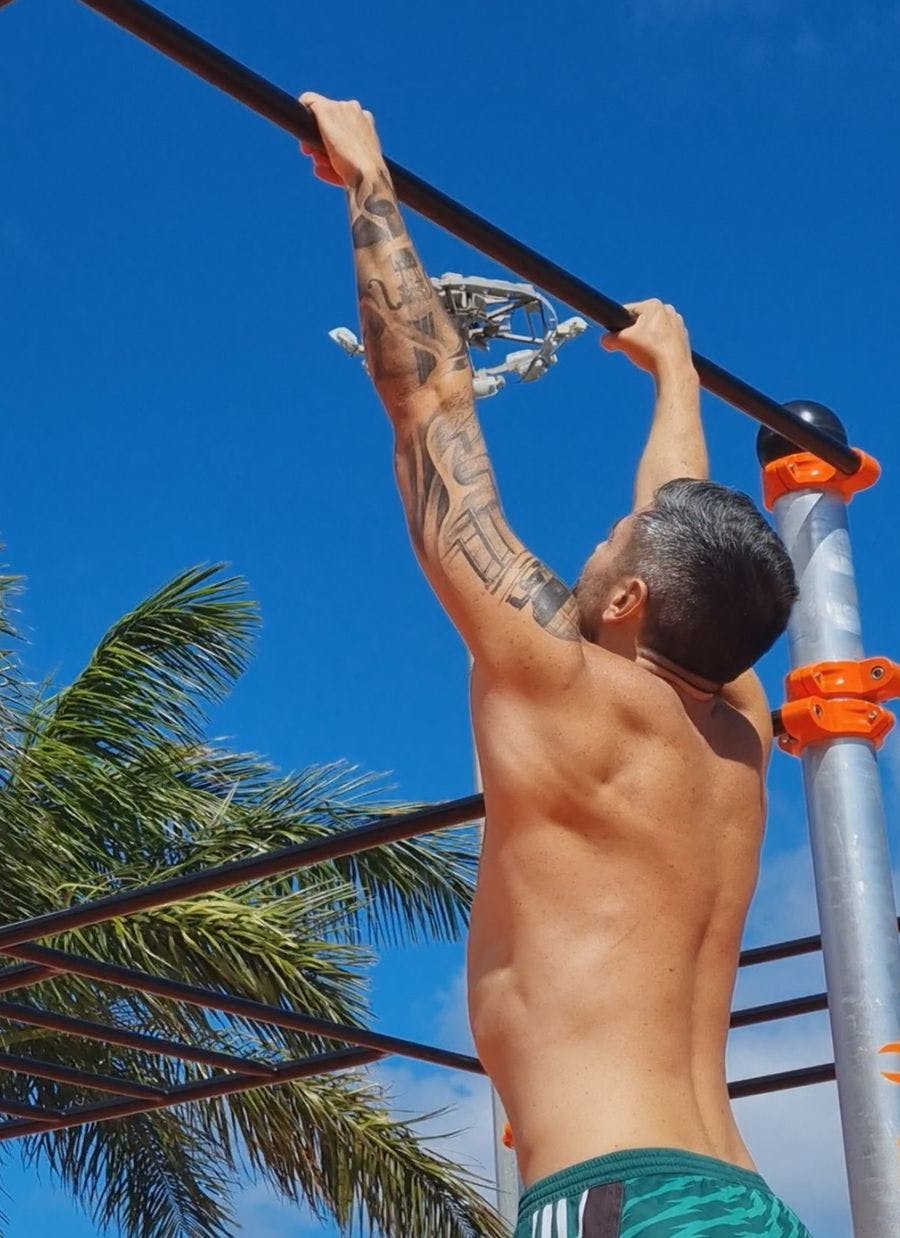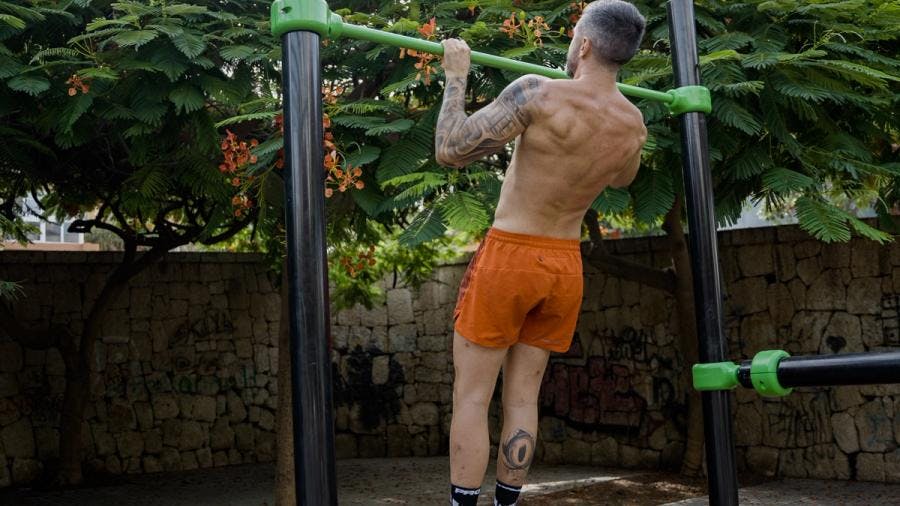
Calisthenics for beginners: exercises and routine
Calisthenics routines for beginners, exercises by level, and complete workout to progress safely and effectively.

In this article I would like to analyze down to the smallest detail what a perfect, totally strict pull-up would look like under the most thorough standards I know. So we will analyze point by point the different characteristics that the perfect pull-up must have and the different parameters that may be debatable.
We will see different points of view whether from calisthenics athletes, endurance competitors, police oppositions or Street Lifting athletes.
So without further ado, let's go point by point analyzing each of the keys to execute this exercise in the cleanest way possible.
I think this is the most obvious, although that does not stop it from being constantly “desecrated” in competitions, record attempts, publications on social networks and so on.
Additionally, there is a bit of disparity regarding what is conceived as a full range. For example, I personally believe that the full range begins hanging completely from the bar and with the elbows fully extended, however many of the most well-known calisthenics endurance athletes do not respect this, leaving a few centimeters of elbow flexion in each repetition and therefore not coming to extend completely.
It's funny because if you ask them, they usually tell you that you have to extend the elbows completely, and in the regulations of all competitions it is usually the rule that you have to extend them completely, but then in practice it doesn't happen.

Regarding the final part of the movement, I personally believe that the ideal is for the chin to pass the height of the bar, but without hyper extension of the neck. To be more exact with this description we could say that the chin should not be at an angle greater than 45º with respect to the horizontal.
Again with this there is also disparity, since, for example, endurance athletes usually perform pull-ups with their neck completely hyper extended.
This is another point that I think everyone understands as necessary but in which I see certain discrepancies.
Regarding knee flexion, I think it is clear that a strict pull-up implies that there is no knee flexion to help you when going up.
Where I see certain differences is in the issue of hip flexion. Since in theory the cleanest thing would be that there is no hip flexion at all, but it is true that when fatigue begins it is practically inevitable, and if we are so strict the numbers of pull-ups would become laughable compared to the current records. Even the strictest ones, such as Isypov, capable of doing more than 100 completely strict pull-ups, begin to include a little hip flexion after a certain number of repetitions.

From my point of view I think that the most correct thing would be to allow some hip flexion but without it being excessive, again a reference could be 45º, a midpoint between the legs completely straight with respect to the back and what would be an L sit. This way we maintain a very strict aesthetic aspect but do not cut short the athlete's ability so abruptly.
I don't see much discussion here. Avoid swinging and any type of kipping (arching of the back that then produces an impulse with the legs). Furthermore, it complements well with the topic of the dead stop that we will discuss below, since the way to avoid swinging is to do this stop with your arms extended so that the timing of the pull-ups counteracts the inertia.
Regarding the grip, I think there is not much problem either, I think we agree that the strict grip is without a false grip (without raising the wrist above the bar), and with the thumb below, although this last point is not very relevant since if someone wants to do them with the thumb on top it is perhaps more a matter of preference as it does not give a clear advantage nor does it spoil the technique.

Another rather dubious aspect. Pull-ups can be done with greater scapular retraction when going up, which makes the chest aim towards the sky, or they can be done with less scapular retraction and the chest is vertical with respect to the ground. None of these approaches is a “cheat” or help unrelated to the exercise, so in that sense there is no problem.
What is true is that when you do the pull-ups with greater scapular retraction, the head is further away from the bar and does not allow the chin to be inserted so that it can clearly be seen that it has passed the height of the bar.
Another thing to keep in mind is that all the athletes who do very heavy pull-ups in Street Lifting do the pull-up without that exaggerated scapular retraction, so it seems that in terms of performance, this version wins. Also the people who do the highest records of very strict repetitions do them in this version without as much retraction.
In my opinion, on an aesthetic level the pull-up with scapular retraction is more beautiful and clean, but I think that in this case both versions should be allowed, since it favors performance without becoming a "cheat" so to speak.

Another point that raises doubts, as I mentioned, is the issue of stopping completely at the bottom. Traditionally it has been considered more strict, since it ensures 100% that you fully extend your arm and eliminates swings or inertia. But it is also true that it can be used advantageously for those who have a lot of grip strength and resistance in their forearms, since for them it can be a small break that allows them to do more repetitions, as is the case with Isypov.
Personally, I don't see much of a problem with this, since grip and forearm strength and resistance is part of the movement and therefore I don't see the problem with taking advantage of it while doing impeccable pull-ups.
- Real full range, elbows fully extended at the bottom and chin clearly passing the bar without hyper extending the neck during flexion.
- Without any type of movement in the knees, and a maximum movement in the hip of 45º with respect to the vertical.
- No swinging or kipping.
- With dead stop at extension of at least 1 second.
I hope I have contributed my grain of sand and that it serves to take into account this issue and the small nuances that may arise.

Yerai Alonso
Cofundador de Calisteniapp, referente en calistenia y el street workout en Español. Con más de una década de experiencia, es creador de uno de los canales de YouTube más influyentes del sector. Autor del libro La calle es tu gimnasio, campeón de Canarias y jurado en competiciones nacionales e internacionales.
Join our newsletter
Learn everything you need to know about calisthenics

Calisthenics routines for beginners, exercises by level, and complete workout to progress safely and effectively.

Learn all about macronutrients: their roles, types, and the importance of nutrient timing for sports performance. Read our complete guide for athletes.

Not sure what to eat before training calisthenics? In this article, we explain the ideal pre-workout nutrition based on your specific type of training session.
